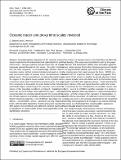Oceanic tracer and proxy time scales revisited
Author(s)
Siberlin, Charlotte A.; Wunsch, Carl Isaac
DownloadWunsch-2011-Oceanic tracer.pdf (1.163Mb)
PUBLISHER_CC
Publisher with Creative Commons License
Creative Commons Attribution
Terms of use
Metadata
Show full item recordAbstract
Quantifying time-responses of the ocean to tracer
input is important to the interpretation of paleodata from sediment
cores – because surface-injected tracers do not instantaneously
spread throughout the ocean. To obtain insights
into the time response, a computationally efficient statetransition
matrix method is demonstrated and used to compute
successive states of passive tracer concentrations in the
global ocean. Times to equilibrium exceed a thousand years
for regions of the global ocean outside of the injection and
convective areas and concentration gradients give time-lags
from hundreds to thousands of years between the Atlantic
and Pacific abyss, depending on the injection region and the
nature of the boundary conditions employed. Equilibrium
times can be much longer than radiocarbon ages – both because
the latter are strongly biased towards the youngest fraction
of fluid captured in a sample, and because they represent
distinct physical properties. Use of different boundary conditions
– concentration, or flux – produces varying response
times, with the latter depending directly upon pulse duration.
With pulses, the sometimes very different transient approach
to equilibrium in various parts of the ocean generates event
identification problems.
Date issued
2011-01Department
Massachusetts Institute of Technology. Department of Earth, Atmospheric, and Planetary SciencesJournal
Climate of the Past
Publisher
European Geosciences Union / Copernicus
Citation
Siberlin, C., and C. Wunsch. “Oceanic tracer and proxy time scales revisited.” Climate of the Past 7 (2011): 27-39. © Author(s) 2011
Version: Final published version
ISSN
1814-9324
1814-9332